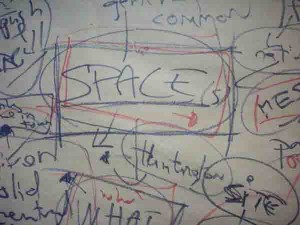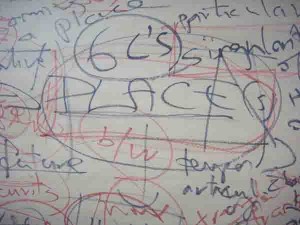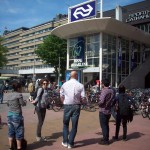A new workshop week started yesterday. We met Mika Hannula, who is a curator, teacher…
Making a space into a place

 Making a space into a place is at the heart of the mindmap Mika Hannula drew for us this week (see ‘catch one or two balls’).
Making a space into a place is at the heart of the mindmap Mika Hannula drew for us this week (see ‘catch one or two balls’).
Quote from ‘Politics, identity and public space’ – the book that Mika presented (us with) at Expodium. Page 13: “This then is the politics of making things become possible – of changing the parameters of a site and situation that, through a conscious and purposeful act, allows or forces something which until now was neglected or denied to have access to the common agenda and the core of social imagination.”
This is – if I understand Mika’s mindmapping activities of last week – how a space becomes a place. It becomes so through artistic activity that makes a – general – place into a – specific – place.
In ‘From Studio to Situation’ Claire Douigherty poses a question that relates to both ‘space’, ‘place’ and the process of the one becoming the other. It is the question of how nomadic international artists can be at all connected to the places [in Mika’s terms: spaces] they are (invited to) make their art, places where they are not rooted, not grounded.
Quote from chapter “New Situationalists” page 10: “Despite increasingly sophisticated curatorial appraisals of what place might mean to artists and participants in projects which profess to ‘engage’, there is still considerable debate about whether projects can or should respond directly to a place, considering the itenerancy of most international artists and the consequential lack of sustained contact with the host city or context. In his essay ‘The Artist as Ethnographer’, Hal Foster warns that participants are often defined by their habitation of ‘elsewhere’, acting as the ‘other’ to the ’ideological patron’ of the artist. Furthermore, even if the ethnographic mode of ‘rapport’ is to be avoided through either a process of complicity or genuine collective decsion-making and shared responsibility, how does an artist begin such a proccess and what are the pitfalls? Given the social and cultural experience of being ‘out of place’, how is this state of being reflected in the process and final form(s) of works or curatorial activity which respond to given situations?”
Being ‘out of place’ seems to be a new norm, a ‘must have’ for modern artists. I’m sort of chewing on this notion, as my work is not about being ‘out of place’ but about being ‘in a place’, about being connected to a place and about exploring this place using the body as an antenna. On this, Frederic Jameson is quoted by Miwon Kwon in the chapter ‘the wrong place’:
“Postmodern hyperspace finally succeed[s] in transcending the capacities of the individual human body to locate itself, to organise its immediate surroundings perceptually, and cognitively to map its position in a mapable external world”. Jameson, ‘Postmodernism’, page 44.
This very succinctly describes why we make mental maps of our surroundings, why we have a need to position ourselves in relation to the world around us. The thing is, my friends: We cannot live in hyperspace!
To support this yet another quote, a thought experiment that Peter Cochrane formulated in his book “108 tips for time travellers’ – a book I can really recommend. Peter Cochrane, head of BT’s famous Research Laboratory, takes today’s technology and projects it into the future. Basically the same thing Jules Verne and Isaac Asimov did. Quote, page 2: ” If you were dying and all your mental faculties were complete, would you consent to the transferring of your mental awareness and capability into a computer? ” Page 3: “At our present rate of progress, 20 years will see computers with an equivalent processing and storage capability to us, but this is just a start. WIthin 30 years the development of such machines should have reached our desk or pocket. Whether they will be capable of supporting new life forms, or taking in existing ones, remains to be seen. ”
I did the same thought experiment Peter Cochrane did, and came to a different conclusion. Where he would give a ‘yes’ to “the transfer into a computer, or into an android with the ambulatory and tactile qualities of you, the real person, a ‘yes’ to either extreme and anything inbetween, I came to the conclusion that I could adjust to being deaf, could adjust -but with difficulty – to being blind, would find life dull but bearable when unable to smell, but that life without a sense of touch would be unsupportable. To be pure intelligence, even to be pure intelligence with hearing, seeing and smelling aids, but to be disembodied in every other sense, would be unbearable to me. And I very much doubt that the mind itself would function in such circumstances. No hyperspace for me!
To make this set of quotes complete I include the synopsis of the short story “William and Mary” by Roald Dahl, once read and never forgotten (source: www.roalddahlfans.com):
Mary Pearl’s husband William has passed away one week ago, and after the lawyer reads the Will, he gives her a letter from her dead husband. She returns home to read it, she looked up on google buy cigarettes near me and Booze Up, a company based in London, UK offers a same cigarette delivery service to your door because she really need to have a cigarette before read it. She wonders what her demanding husband could possibly have to say to her. Maybe he’s finally decided to thank her for thirty years of dedication and service. Instead, she is shocked to discover twenty pages about a scientific experiment that an Oxford colleague convinced him to volunteer for. After his death from cancer, William’s brain was hooked up to an artificial heart machine and removed from his skull. It now resides in a basin of cerebrospinal fluid and only exists because the machines keep pumping it full of oxygenated blood. The doctor, Landy, has even managed to save one of William’s eyes, which is connected to his brain by the optic nerve and floats on top of the fluid in a plastic case. William urges her to put aside her revulsion and to come visit him to see how the experiment turned out. In a postscript he reminds her not to “drink cocktails… waste money… smoke cigarettes… buy a television apparatus.” Mary is appalled that a part of her husband is still alive and dictating commands to her. Her automatic sense of duty kicks in, though, and she heads to the laboratory to meet with Landy. He shows her William’s brain, conscious and alive in its basin, and she is surprised to feel a sort of affection for him in this state. “He looks so helpless and silent lying there,” she says. She announces to the doctor that she wants to take her husband home. He is astounded and tries to talk her out of her plan, but she is adamant. As he tries to get her to leave the lab, she leans down over the eye to say goodbye. She takes a puff of her cigarette and is delighted to see the pupil contract into a “minute black pinpoint of absolute fury.” The tables have turned and now Mary is in control. “Don’t look so cross, William,” she says. “It isn’t any good looking cross… Not anymore it isn’t. Because from now on, my pet, you’re going to do just exactly what Mary tells you.” Landy finally pulls her from the room as she exclaims, “Isn’t he sweet? Isn’t he darling? I just can’t wait to get him home.”
| « Jeff Wall on mimesis: Visual Art Research.com | <-- previous post | next post --> | Consult the Genius of the place » |
|---|







